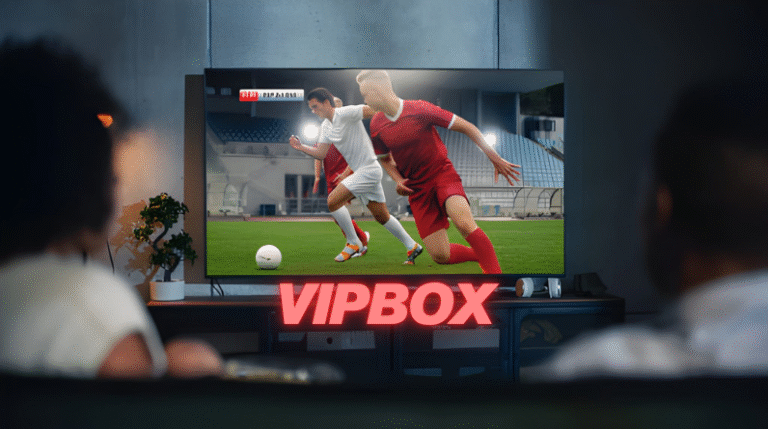The landscape of sports streaming has undergone dramatic transformation over the past decade. At the center of this evolution stands VIPBox, a platform that once served millions of sports enthusiasts seeking free access to live games. This comprehensive analysis explores what VIPBox represented, why it attracted such a massive following, and what the platform’s trajectory tells us about the future of sports entertainment consumption.
What Was VIPBox and Why Did It Matter?
VIPBox emerged as more than just another streaming website. It became a cultural phenomenon that highlighted a fundamental disconnect between how sports fans wanted to consume content and how traditional broadcasters delivered it.
Launched around 2015, VIPBox positioned itself as an aggregator platform, collecting and organizing links to live sports streams from across the internet. The platform’s appeal was straightforward: watch any major sporting event without subscriptions, contracts, or geographic restrictions.
The Core Appeal That Drew Millions
VIPBox’s popularity wasn’t accidental. The platform addressed several pain points that traditional sports broadcasting failed to solve:
- Cost Accessibility: With cable packages often exceeding $100 monthly and individual sports subscriptions adding another $10-30 each, VIPBox offered zero-cost access
- Global Reach: Fans in regions without official broadcasting deals could finally watch their favorite teams
- Multiple Sports Coverage: From mainstream NFL and NBA to niche motorsports and cricket, everything was available in one place
- Device Flexibility: The platform worked across smartphones, tablets, and computers without requiring special apps
- No Commitment Required: Users could watch occasionally without paying for months they didn’t use the service
The Numbers Behind VIPBox’s Growth
Understanding VIPBox’s impact requires examining the data that demonstrated its massive reach and influence on sports consumption patterns.
| Year | Monthly Visitors | Key Development | Market Impact |
|---|---|---|---|
| 2015 | Initial Launch | Forum-based distribution | Early adopter phase |
| 2017 | 300,000 | Improved interface | Community building |
| 2019 | 800,000+ | Mobile optimization | Mainstream awareness |
| 2020 | 1.2 million | Advanced streaming tech | Peak performance period |
| 2025 | Original domains shut down | Legal enforcement | Transition to alternatives |
These statistics reveal more than just growth—they demonstrate a genuine market need that traditional broadcasters weren’t adequately addressing.
The Technical Innovation Behind the Platform
While VIPBox operated in legally questionable territory, its technical achievements deserve recognition for pushing the industry forward.
Streaming Technology That Set Standards
VIPBox implemented several innovations that mainstream platforms later adopted:
- Adaptive Bitrate Streaming: Automatically adjusted video quality based on user connection speeds
- Distributed Server Architecture: Used multiple servers globally to reduce latency and handle traffic spikes
- Mobile-First Design: Recognized early that 65% of users would access content via smartphones
- Minimal Buffering: Achieved less than 1% buffering rates during normal traffic conditions
- Peak Performance Capacity: Handled 500,000 simultaneous users during major sporting events
These technical specifications weren’t just impressive—they demonstrated what viewers expected from streaming services, pressuring legitimate platforms to improve their own infrastructure.
Understanding the Legal Quagmire
VIPBox’s relationship with copyright law represents one of the most complex aspects of modern digital content distribution.
Why VIPBox Operated in Gray Areas
The platform’s legal strategy relied on a technicality: VIPBox itself didn’t host sports content. Instead, it aggregated links to streams hosted elsewhere. This approach raised questions:
- Does linking to copyrighted content constitute infringement?
- Who bears responsibility—the host, the linker, or the viewer?
- How do international jurisdictions affect enforcement?
- Can platforms claim safe harbor protections?
Courts and regulatory agencies struggled with these questions throughout VIPBox’s operational years. The platform changed domains frequently, moved servers across jurisdictions, and adapted to each new legal challenge.
The Copyright Holders’ Perspective
Sports leagues and broadcasters invested billions in content rights. A single NFL broadcasting contract can exceed $2 billion annually. When platforms like VIPBox offered free access, it threatened this entire economic model.
Major sports organizations reported that unauthorized streaming potentially cost them hundreds of millions in lost subscription revenue. This motivated aggressive legal action, including:
- DMCA takedown notices targeting individual streams
- Domain seizures through court orders
- ISP-level blocking in multiple countries
- Pressure on payment processors and advertisers
The Security Risks Nobody Talks About Enough
Beyond legality, VIPBox and similar platforms posed genuine security threats that many users underestimated.
The Hidden Dangers of Free Streaming
| Security Risk | How It Happens | Potential Impact |
|---|---|---|
| Malware Installation | Malicious ads or fake play buttons | Device compromise, data theft |
| Phishing Attacks | Fake login pages mimicking real services | Stolen credentials, identity theft |
| Cryptocurrency Mining | Hidden scripts running in browser | Device slowdown, increased electricity costs |
| Data Harvesting | Tracking cookies and browser fingerprinting | Privacy violation, targeted attacks |
| Unwanted Subscriptions | Deceptive pop-ups and redirects | Financial loss, recurring charges |
Real-world example: In 2023, cybersecurity researchers identified multiple VIPBox mirror sites distributing the RedLine Stealer malware, which harvested passwords, cryptocurrency wallets, and credit card information from infected devices. Thousands of users were compromised before the threat was widely publicized.
What Happened to VIPBox in 2025?
The original VIPBox domains are no longer operational. Coordinated enforcement actions by copyright holders, combined with ISP-level blocking in major markets, effectively shut down the primary platform.
The Current State of Affairs
While the main VIPBox site disappeared, the situation is more nuanced:
- Mirror Sites Persist: Dozens of copycat sites claim to be “the new VIPBox,” but most are less reliable and more dangerous
- Increased Risks: Without the original platform’s relative stability, mirror sites often contain more aggressive malware
- User Migration: Former VIPBox users have dispersed across multiple alternative platforms
- Enforcement Continues: Authorities actively monitor and shut down new unauthorized streaming sites
The Broader Lesson: What VIPBox Taught the Industry
VIPBox’s rise and fall offers valuable insights for broadcasters, technology companies, and policymakers.
Market Signals That Couldn’t Be Ignored
The platform’s 1.2 million monthly users at its peak sent a clear message: traditional sports broadcasting wasn’t meeting consumer needs. Specifically:
- Pricing Concerns: Consumers felt sports packages were too expensive for casual viewing
- Fragmentation Frustration: Following multiple sports required subscribing to numerous services
- Geographic Inequity: Many regions had no legal way to watch certain leagues
- Technical Expectations: Viewers demanded mobile-friendly, low-latency streaming
- Flexibility Needs: People wanted to pay only for what they watched
Industry Responses and Evolution
VIPBox’s success prompted legitimate services to adapt:
- Introduction of more affordable tier packages
- Single-game purchase options instead of season-long commitments
- Improved mobile applications and streaming quality
- Free trial periods to attract hesitant subscribers
- International expansion of official streaming rights
Legitimate Alternatives: Where Sports Fans Should Turn in 2025
The good news is that the sports streaming landscape has improved significantly, offering legal options at various price points.
Official League Platforms
Most major sports leagues now offer direct-to-consumer streaming:
- NFL+: Starting at $6.99/month for mobile streaming
- NBA League Pass: Full season access with various package options
- MLB.TV: Watch out-of-market games with blackout restrictions
- UFC Fight Pass: Comprehensive combat sports coverage
Multi-Sport Streaming Services
These platforms offer broader coverage across multiple leagues:
- ESPN+: Affordable at $10.99/month, extensive college sports and international leagues
- DAZN: Combat sports and soccer focus, available globally
- Peacock: Premier League, Sunday Night Football, Olympics content
- Paramount+: Champions League, Serie A, NFL on CBS
Free Legal Options
Not everything requires a subscription:
- Pluto TV Sports: Free channels with live sports and replays
- YouTube: Many leagues stream select games officially
- Network Apps: NBC, ABC, and Fox stream some games free with antenna verification
- Tubi Sports: Growing selection of live events and documentaries
Making the Smart Choice: Cost vs. Risk Analysis
When deciding between unofficial streams and legitimate services, consider this breakdown:
| Factor | Unofficial Streams (VIPBox-style) | Legitimate Services |
|---|---|---|
| Monthly Cost | $0 | $7-$80 depending on service |
| Legal Risk | Potential fines, ISP warnings | None |
| Security Risk | High (malware, phishing) | Minimal |
| Stream Quality | Inconsistent, often 720p or lower | Reliable HD/4K with HDR |
| Device Support | Limited, browser-dependent | Full app ecosystem |
| Customer Support | None | 24/7 professional assistance |
| Additional Features | None | DVR, stats, multiple angles |
The Future of Sports Streaming: Lessons from VIPBox
VIPBox’s story isn’t just about one platform—it’s about the ongoing tension between content access and copyright protection in the digital age.
Trends Shaping Tomorrow’s Landscape
Several developments suggest how sports streaming will evolve:
- Flexible Pricing Models: More services offering pay-per-game or weekly passes
- Bundling Strategies: Partnerships between streaming services to offer comprehensive packages
- International Expansion: Legitimate services reaching previously underserved markets
- Technology Integration: AR/VR features, interactive statistics, and social viewing options
- Advertising-Supported Tiers: Free or discounted access with commercial interruptions
What Consumers Can Do
Sports fans have more power than they realize in shaping this market:
- Provide feedback to services about pricing and features
- Support flexible viewing options when offered
- Share concerns about geographic restrictions
- Choose services that respect fair access principles
- Advocate for reasonable copyright enforcement that doesn’t punish consumers
Final Thoughts: Moving Beyond the VIPBox Era
VIPBox represented both a problem and a solution—a problem for rights holders protecting their investments, and a solution for fans frustrated by inaccessible or overpriced content.
The platform’s shutdown in 2025 marks the end of an era, but the underlying issues that drove its popularity remain relevant. The future of sports streaming will be determined by whether legitimate services can learn from what VIPBox got right: accessibility, simplicity, and user-focused design.
For today’s sports fans, the choice is clearer than ever. Legitimate streaming options have improved dramatically, offering better quality, security, and reliability than unofficial alternatives ever could. While the cost may be higher than “free,” the value proposition—legal safety, consistent performance, and supporting the sports we love—makes it the smarter long-term choice.
The VIPBox chapter taught the industry that consumers want fair access to sports content. Now it’s up to broadcasters, leagues, and streaming platforms to deliver on that expectation while respecting both intellectual property rights and viewer needs. The balance isn’t perfect yet, but we’re closer than we’ve ever been.
Looking for well-researched content and timely updates? Keep visiting VIPLeague.

